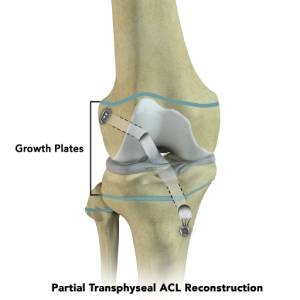Partial Transphyseal Surgery
What is Partial Transphyseal ACL Reconstruction Surgery?

Partial transphyseal surgery is an arthroscopically assisted operative procedure to reconstruct the anterior cruciate ligament (ACL) in the knee of a child or adolescent with open growth plates, which are also known as physes (areas near the ends of long bones where growth is still occurring). Reconstruction of the ACL is performed using a soft-tissue graft, which is passed through tunnels drilled into the very top of the shinbone (tibia) and the very bottom of the thighbone (femur) at the level of the knee joint. Partial transphyseal surgery is performed to minimize injury to the physis, which could potentially affect growth and result in in differences between the lengths of the bones between each leg and/or differences in the angle at which the bones are growing between each leg. The tunnel is created such that it passes centrally through the physis of the tibia while avoiding the physis of the femur.
Indications for Partial Transphyseal Surgery
An orthopedic surgeon may recommend ACL reconstruction via partial transphyseal surgery for active children and adolescents who still growing, but are interested in remaining involved in sports or recreational activities. Because knee instability due to an ACL tear can lead to meniscal and cartilage injuries and early onset of arthritis, ACL reconstruction is designed not only to allow patients to have improved knee stability for cutting and pivoting activities, like sports, but also as an act of joint preservation, to prevent other injuries to structures in the knee joint.
Partial transphyseal surgery is preferred for kids who have at least 1 year or more of growth from the growth plate remaining.
Benefits of Partial Transphyseal Surgery
The benefits of partial transphyseal surgery include:
- The femoral physis, which is the most active growth plate, of any, in contributing to lower extremity growth, is avoided, thus lowering the rate of complications, such as leg length discrepancy and angular deformity
- Improved knee stability
- Allows return to sports following adequate rehabilitation
How to Prepare for Partial Transphyseal Surgery
Your doctor may recommend using a brace to provide improved stability while the knee partially recovers from the initial injury and possibly allow healing of other knee ligaments before surgery is performed. You may need to undergo physical therapy to improve range of motion and allow knee swelling to go down. If the knee is stiff or swollen at the time of surgery, restoring range of motion may be difficult after the surgery, which could affect the success of the procedure. You may be given specific instructions on ‘do’s’ and ‘don’ts’ before and on the day of your surgery. Instructions may include details on food intake, medication, etc.
How Partial Transphyseal Surgery Works
Hamstring tendons on the inner side of the knee (inner thigh muscle) or a portion of the quadriceps tendon (which connects the thigh muscle to the top of the kneecap) are most commonly used as a graft in partial transphyseal ACL reconstruction surgery. The tendon(s) is prepared and is secured with special instruments on either side of the joint, and is designed to serve as the ‘new’ ACL, which is the main stabilizing ligament for the knee. Some steps in the surgery include:
- Small incisions are made in the knee to allow for insertion of an arthroscope and instruments.
- The torn or injured ACL is debrided (removed), to make room for the new ACL graft.
- A small tunnel is drilled near the middle of the tibia (shin bone), and is oriented almost vertically to pass through the tibial physis to minimize damage.
- Another tunnel is drilled through the femur that does not pass through the physis.
- The graft is passed through the tunnels and secured to the bone.
- The incisions are closed and a dressing is applied.
Risks Associated with the Procedure
As with any surgery, partial transphyseal ACL reconstruction has its own risks, including:
- Cartilage injury
- Growth disruption from effects on the growth plate (can happen even when the special measures of the technique are designed to minimize the chance of any effects on the growth plate)
- Rupture of reconstructed ACL (i.e. graft tearing) due to a twisting injury or collision
- Scar tissue formation restricting joint movement
Recovery after Partial Transphyseal Surgery
Rehabilitation is very important to help you return to your regular activities and sports. You will work with a physical therapist to help you safely achieve these goals. Therapy is initiated within 1-2 weeks following surgery and will focus on improving range of motion and strength. You will have to adhere to certain activity limitations initially. As you progress with therapy, the focus shifts towards improving balance and neuromuscular control. Around 3 months, you may be able to jog, and agility exercises and sport-specific training can usually be safely introduced between 4-6 months after surgery. Special training to optimize movement patterns during athletics can help prevent future knee injuries, such as re-tear of the ACL graft. Generally strength, balance, and agility exercises are felt to be beneficial for the long term, even after formal physical therapy sessions have stopped, and may decrease the chances of an ACL re-tear.
